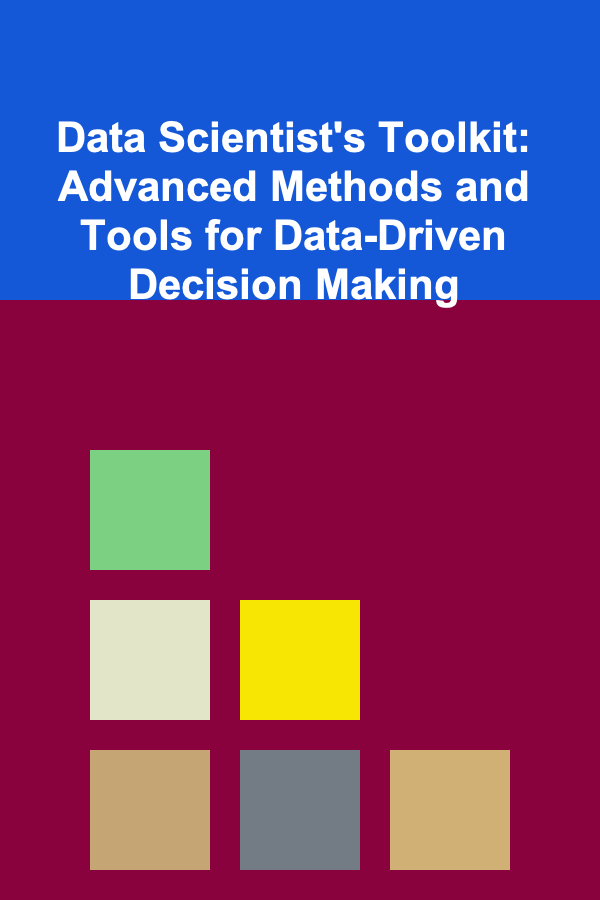
Data Scientist's Toolkit: Advanced Methods and Tools for Data-Driven Decision Making
ebook include PDF & Audio bundle (Micro Guide)
$12.99$8.99
Limited Time Offer! Order within the next:

In the age of big data, the role of a data scientist has evolved beyond basic data analysis into one that requires a deep understanding of machine learning algorithms, statistical methods, and advanced tools. Data-driven decision-making has become critical for businesses, governments, and organizations across industries, making data science one of the most valuable skills today.
This guide dives into the advanced methods and tools that form the essential toolkit for a data scientist, empowering them to extract actionable insights from complex datasets and inform data-driven decision-making.
Advanced Statistical Methods for Data Science
1.1. Bayesian Inference
Bayesian statistics offers a powerful framework for updating beliefs in the light of new evidence. Unlike frequentist statistics, which evaluates the probability of a hypothesis based on fixed data, Bayesian methods allow for probabilistic reasoning and incorporate prior knowledge into the model.
Key Concepts:
- Prior: The initial belief or knowledge about a parameter before new data is observed.
- Likelihood: The probability of observing the data given a certain model.
- Posterior: The updated belief after observing the data.
Bayesian methods are particularly useful in situations with sparse data or where domain knowledge plays a crucial role. Applications range from machine learning (e.g., Bayesian networks) to A/B testing and even natural language processing (NLP).
Tools:
- PyMC3 and Stan are popular libraries for implementing Bayesian models in Python and R.
- JAGS: A program for running Bayesian models using Gibbs sampling.
1.2. Time Series Analysis and Forecasting
Time series analysis is crucial for data scientists dealing with sequential data (e.g., stock prices, sensor data, or sales over time). It involves techniques that capture temporal dependencies and forecast future values based on historical data.
Key Techniques:
- ARIMA (AutoRegressive Integrated Moving Average): A classical method that models the relationship between an observation and a number of lagged observations.
- Exponential Smoothing: A family of methods for forecasting that gives more weight to recent observations.
- Seasonal Decomposition: Decomposing the time series into trend, seasonality, and residual components.
Advanced Models:
- Prophet: A forecasting tool developed by Facebook that works well with time series data that exhibits seasonality and holidays.
- LSTM (Long Short-Term Memory networks): A type of recurrent neural network (RNN) for sequential data that learns long-term dependencies.
Tools:
- statsmodels: Python library for time series analysis, offering ARIMA and other classical methods.
- Prophet: Open-source forecasting tool for time series analysis, developed by Facebook.
- TensorFlow/Keras: Libraries for building deep learning models like LSTMs for time series forecasting.
Machine Learning Techniques for Advanced Analysis
2.1. Ensemble Learning
Ensemble methods combine multiple machine learning models to improve performance. By aggregating predictions from several models, these techniques often yield better accuracy than any single model.
Common Techniques:
- Bagging (Bootstrap Aggregating) : Involves training multiple models (usually decision trees) on different subsets of the training data and averaging the results to reduce variance. Example: Random Forest.
- Boosting : Involves sequentially training models, where each model tries to correct the errors made by the previous one. Examples: Gradient Boosting and XGBoost.
- Stacking: A technique that trains multiple different models and combines their outputs through a meta-model, typically using a logistic regression or linear regression model as the final decision maker.
When to Use:
- When overfitting is a concern (bagging reduces overfitting).
- When the dataset is large, complex, and may benefit from multiple perspectives (boosting and stacking).
Tools:
- Scikit-learn: Python library that includes implementations for Random Forest, Gradient Boosting, and other ensemble methods.
- XGBoost: Highly optimized and scalable library for boosting methods, particularly useful for structured/tabular data.
2.2. Deep Learning and Neural Networks
Deep learning, a subset of machine learning, involves the use of neural networks with many layers to model complex patterns in data. It has revolutionized fields like image recognition, speech processing, and natural language understanding.
Key Concepts:
- Convolutional Neural Networks (CNNs): Specialized neural networks for processing grid-like data (e.g., images).
- Recurrent Neural Networks (RNNs): Neural networks designed for sequential data, commonly used in time series, language modeling, and speech recognition.
- Autoencoders: Neural networks used for unsupervised learning tasks like anomaly detection and dimensionality reduction.
When to Use:
- For unstructured data such as images, audio, and text.
- When you have large datasets and computational power to support model training.
Tools:
- TensorFlow and Keras: Popular deep learning frameworks that allow for fast prototyping and production of neural network models.
- PyTorch: A flexible deep learning framework favored by researchers for its ease of use and dynamic computation graph.
2.3. Natural Language Processing (NLP)
NLP allows machines to understand and process human language. It involves both theoretical linguistics and machine learning techniques, with a wide range of applications from sentiment analysis to machine translation.
Key Tasks:
- Text Preprocessing: Tokenization, stemming, lemmatization, stopword removal, and vectorization of text data.
- Sentiment Analysis: Determining the sentiment (positive, negative, neutral) of a given text.
- Named Entity Recognition (NER): Identifying and classifying named entities (persons, organizations, locations) in a text.
- Topic Modeling : Unsupervised learning technique for discovering the hidden topics in a corpus of documents. Common methods include Latent Dirichlet Allocation (LDA).
Tools:
- spaCy: A popular NLP library for tasks like tokenization, part-of-speech tagging, and named entity recognition.
- NLTK (Natural Language Toolkit): A comprehensive Python library for text processing and analysis.
- Transformers (by Hugging Face): A cutting-edge library for state-of-the-art pre-trained language models such as BERT and GPT.
Big Data Tools and Technologies
Handling large datasets requires specialized tools and technologies that can process data at scale. The following tools are essential for data scientists working with big data.
3.1. Apache Spark
Apache Spark is an open-source, distributed computing system that allows for the processing of large datasets in parallel across clusters. It provides APIs for both batch and real-time data processing.
Key Features:
- Resilient Distributed Datasets (RDDs): A distributed data structure that allows for fault-tolerant data processing.
- Spark SQL: Enables querying structured data using SQL syntax.
- MLlib: A library within Spark that provides machine learning algorithms for scalable analysis.
When to Use:
- When working with large datasets that cannot fit into memory on a single machine.
- For distributed computing and real-time data processing.
Tools:
- PySpark: The Python API for Apache Spark.
- SparkR: The R interface for Apache Spark.
3.2. Hadoop
Hadoop is another open-source framework that allows for the distributed storage and processing of large datasets. While Spark has gained popularity for its speed, Hadoop's ecosystem remains widely used for batch processing.
Key Components:
- HDFS (Hadoop Distributed File System): A distributed storage system designed for storing large datasets across multiple nodes.
- MapReduce: A programming model for processing and generating large datasets in parallel.
When to Use:
- When dealing with very large datasets that require distributed storage and processing.
- For batch processing of data in a cost-effective manner.
Tools:
- Hadoop MapReduce: For distributed processing.
- Hive: A data warehouse infrastructure built on top of Hadoop for querying large datasets using a SQL-like language.
Data Visualization Tools for Effective Communication
Data visualization is a crucial step in data science as it helps to convey insights clearly and effectively to stakeholders. The following tools help data scientists create compelling visualizations.
4.1. Tableau
Tableau is a powerful business intelligence tool used for creating interactive visualizations and dashboards. It allows for easy connection to multiple data sources and enables real-time data exploration.
Key Features:
- Drag-and-Drop Interface: Makes it easy to create complex visualizations without coding.
- Real-time Data Connection: Connects to live databases and updates visualizations in real time.
- Advanced Analytics: Allows for trend analysis, forecasting, and statistical modeling within visualizations.
4.2. Power BI
Power BI, developed by Microsoft, is another popular data visualization tool. It provides interactive dashboards and reports that can be shared across an organization.
Key Features:
- Integration with Microsoft Products: Seamlessly integrates with Excel, Azure, and other Microsoft services.
- Custom Visualizations: Offers a wide variety of visualization options and custom visuals for different needs.
4.3. Plotly and Matplotlib
For more custom visualizations in Python, Plotly and Matplotlib offer a wide range of options to create interactive and static plots, respectively.
Tools:
- Plotly: A library for creating interactive, web-based visualizations.
- Matplotlib: A foundational Python library for static visualizations that can be customized to meet specific needs.
Conclusion
A data scientist's toolkit is vast and varied, consisting of a blend of advanced statistical techniques, machine learning algorithms, big data tools, and visualization tools. Mastering these methods and tools is crucial for deriving actionable insights from complex datasets and making informed, data-driven decisions.
As the field of data science continues to evolve, data scientists must remain adaptable and continuously learn new methods, tools, and technologies. By embracing these advanced techniques and tools, data scientists can empower organizations to not only analyze data but also harness it to solve real-world problems and drive innovation.

How to Celebrate Family Traditions Through Seasonal Activities
Read More
How to Coordinate Conference Registration: A Simple Checklist
Read More
How to Use Baskets for Stylish Storage in Every Room
Read More
The Benefits of Utilizing Free Community Events and Activities for Personal Growth
Read More
How to Master Wilderness First Aid (Advanced)
Read More
How to Plan Your Career Growth: A Yearly Professional Development To-Do List
Read MoreOther Products

How to Celebrate Family Traditions Through Seasonal Activities
Read More
How to Coordinate Conference Registration: A Simple Checklist
Read More
How to Use Baskets for Stylish Storage in Every Room
Read More
The Benefits of Utilizing Free Community Events and Activities for Personal Growth
Read More
How to Master Wilderness First Aid (Advanced)
Read More